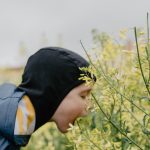By Andrea Lucy, Experiential Learning Program Lead
Cooking with kids can be chaotic, fun, challenging, exhausting, and rewarding. Not every recipe will turn out perfectly; vegetables will be oddly cut and measurements may be skewed, but that’s okay! It’s the experience that matters. Cooking and eating together allows us to celebrate the joy of food and fosters exploration of new foods and recipes. And we can show kids that veggies are delicious!
Our food messaging is always positive, and we meet kids where they are at. Love veggies? Try a new one, or a new way of preparing it! Don’t like veggies? Try an adventure bite! Really hate veggies? Help prepare them, so you can see what they look and smell like, even if you aren’t ready to taste it today.
What do we cook?
At Fresh Roots, we love veggie-forward snacks and meals. Our meal ideas often start from the kids’ interests. Kids may make their own “farm candies” by wrapping up seeds and petals in a kale leaf wrapper with a stem tie. Other times, kids will request a specific meal, like tacos or pesto.
There are many snacks and meals you can make outside without electricity. We regularly make a big salad with a shaken dressing, or fresh spring rolls with rice paper. Pesto can be made with a mortar and pestle (and elbow grease), or no-bake cookies using pumpkin puree. Some tried and true kid-approved recipes are:
- Salsa verde
- Black bean tacos
- Fresh spring rolls
- Nori rolls
- Carrot top pesto
- Fresh Roots salad dressing
- Pea-camole (Sarah Cook, BBC recipe)
Cooking helps kids build a relationship with food, and with those they are cooking and sharing the meal with. Kids learn to read a recipe, grasp the basics of fractions through measurement, and working together as a team.
How do we cook outside?
Luckily, it doesn’t take many supplies to cook outside. We have a table or two and a nearby outdoor sink for hand washing (a laundry sink with a hose attached is a simple DIY). Usually the only other tools we need is the food, cutting boards, knives, and serving dishes.
We practice food safety, and the kids love to help! We set-up a dishwashing station with three bins of water: 1 with dish soap, one with plain rinsing water, and the last with a food-safe amount of bleach. The dishes then go to a dishrack or are dried with cloths. Dishwashing in this way is like water play, with soap bubbles! It’s not unusual for the kids to beg for extra dishes to wash.
How to teach knife skills?
You give kids knives?!?!? Yes, all the time, and they do incredibly well with them even at a young age. When it comes to using knives, we emphasize again and again that they are a tool and safety comes first. So, how can you teach a kid who has never used a knife to chop safely?
- We love starting off new chefs with plastic cooking knives. They can cut through most soft vegetables, but not through skin. A miracle tool for letting kids figure out how to chop and safely make mistakes. Even though we use plastic knives, we ask kids to pretend they are sharp metal when practicing. Once they feel comfortable and confident using plastic knives, then we graduate up to sharp ones.
- Go over knife safety with the kids:
- When cutting, eyes are always on the knife
- Safety bubble from other people
- The hand holding the food makes a “bear-claw”. This protects your fingers in case the knife slips.
Where to get food?
One of the beautiful things about cooking outside is that you can prepare meals right where the food grows — true farm-to-table cooking! We’re fortunate to steward bountiful farms and gardens on school grounds. Oftentimes there is food growing right outside our doors, we just have to look.
Many grocery stores have a rack with produce that is deeply discounted because it’s considered imperfect or over-ripe. Cooking with this food is a great way to naturally bring in discussions about food waste and ways to reduce waste in our food system. There are a number of organizations diverting large amounts of produce from the landfill by connecting it with charities and schools (ex. Food Runners).
Lastly, we’re grateful to receive donations from local food producers and suppliers. Fresh Roots once again received a generous donation from Nature’s Path, a local organic food producer, to support our kids and youth cooking programs.

































